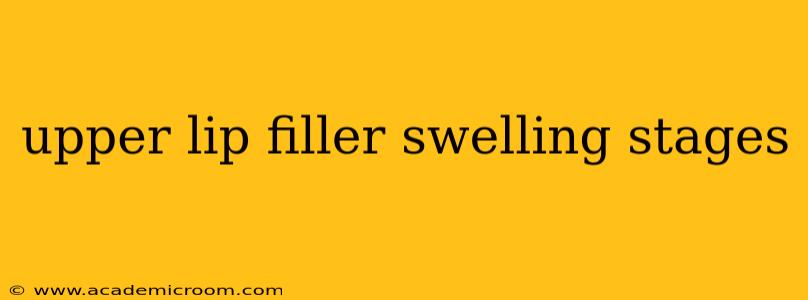Getting lip filler is a popular cosmetic procedure, offering a subtle or dramatic enhancement depending on your desired outcome. However, understanding the swelling stages after upper lip filler is crucial for managing expectations and ensuring a smooth recovery. This comprehensive guide will walk you through each stage, offering insights into what to expect and how to best manage any discomfort.
What are the Stages of Swelling After Upper Lip Filler?
The swelling process after upper lip filler injection is generally predictable, although individual experiences may vary slightly. Here's a breakdown of the typical stages:
Immediately After Injection:
Right after the procedure, you might experience immediate, localized swelling. This is a normal response to the injection itself and the introduction of filler into the lip tissue. The swelling might be minimal for some, while others experience more noticeable puffiness. This initial swelling is often accompanied by some slight bruising or redness.
First 24-48 Hours:
During this period, the swelling will typically reach its peak. Your lips might feel significantly fuller and potentially tender to the touch. Ice packs applied regularly can help minimize swelling and discomfort during this phase. Avoid strenuous activity and excessive facial expressions that could exacerbate the swelling.
Days 3-7:
As the body begins to adjust to the filler, the swelling gradually subsides. You'll likely notice a significant reduction in puffiness during this week. However, some residual swelling may still be present. The final result is still settling and won't be fully apparent just yet.
Week 2 Onward:
By the second week, most of the swelling should have resolved. The filler will continue to settle and integrate naturally into your lip tissue. The final, natural-looking result becomes increasingly apparent during this time. However, subtle changes may still occur for a few more weeks.
How Long Does Upper Lip Filler Swelling Last?
The duration of swelling varies from person to person, but generally speaking, most of the swelling will subside within 7-10 days. However, some subtle swelling can persist for several weeks, even up to a month. Factors influencing the duration of swelling include:
- Type of filler: Different fillers have varying properties affecting swelling. Some are designed for less swelling than others.
- Injection technique: The skill and precision of the injector play a role in minimizing trauma and thus swelling.
- Individual healing response: Your body's natural healing process influences how quickly swelling diminishes.
- Pre-existing conditions: Certain medical conditions or medications might influence healing time.
What Can I Do to Minimize Swelling After Upper Lip Filler?
Several strategies can help minimize swelling and discomfort:
- Ice packs: Apply ice packs regularly during the first 24-48 hours to reduce inflammation.
- Elevation: Keep your head elevated while sleeping to reduce fluid buildup.
- Avoid strenuous activity: Refrain from intense exercise or activities that increase blood flow to the face.
- Gentle touch: Avoid excessive touching or rubbing of the lips.
- Follow post-procedure instructions: Adhere carefully to all aftercare instructions provided by your injector. This includes any medication or topical applications.
- Arnica: Some patients find that arnica supplements or creams help reduce bruising and swelling. (Always consult your doctor before using arnica.)
- Hydration: Drink plenty of water to aid in the body’s healing process.
Is Swelling After Upper Lip Filler Normal?
Yes, swelling after upper lip filler is a completely normal and expected part of the healing process. While the level of swelling varies, some degree of it is typical. If you experience excessive or prolonged swelling, or any other concerning symptoms, contact your injector immediately.
When Should I Be Concerned About Swelling?
While some swelling is normal, it’s essential to contact your injector if you experience:
- Excessive swelling that doesn't improve after a week: This could indicate a complication or allergic reaction.
- Severe pain or discomfort: Unusual pain may signify an issue.
- Signs of infection: Redness, pus, or increased tenderness are signs of potential infection.
- Asymmetry: If one side of your lip looks significantly different from the other, contact your doctor immediately.
Remember, open communication with your injector is key. Don’t hesitate to reach out with any questions or concerns throughout the recovery process. By understanding the upper lip filler swelling stages and following appropriate aftercare, you can ensure a smoother and more comfortable recovery journey.
